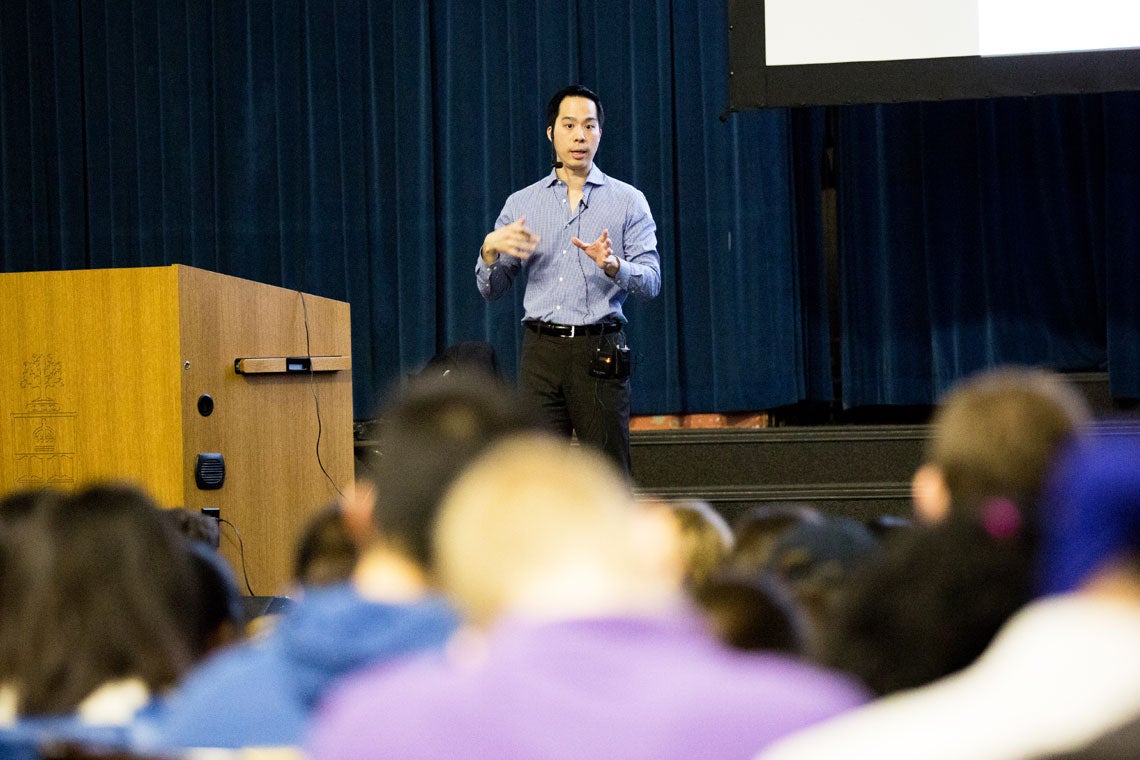Innovations in teaching: Inside Con Hall with Kenneth Yip
Published: May 20, 2016
In just a few weeks, Convocation Hall will begin hosting graduation ceremonies for an expected 13,500 University of Toronto students.
But during the school year Con Hall also serves as the largest classroom at the largest university in Canada.
So what’s it really like to learn in a room with 1,500 fellow students? And what’s it like to teach in that famous rotunda?
In this series, U of T News student reporter Krisha Ravikantharaja goes Inside Con Hall to see why some of U of T’s most popular professors and classes can be found under the dome.
10:00am. Kenneth Yip stands behind the podium, reviewing lecture slides one last time.
10:05am. Yip tucks the wire of his mic into his shirt collar. He takes a quick drink of water.
10:10am. The lights dim and a hush falls over the class. It’s a class of 1,500 students which makes the hush kind of remarkable.
A few quick announcements about tutorial meetings, a brief explanation on his own research on drug discovery – which Yip is sure to clarify is not about “trying to find the new weed or crack, but drugs to treat diseases like cancer” – and it’s straight into the material.
This is Yip’s first lecture at Con Hall this semester, but he has been teaching Animal Physiology (BIO272) and Molecular and Cell Biology (BIO130) in large lecture halls, including Con Hall, since 2010.
Con Hall poses a unique set of challenges, Yip says, but there are strategies that can facilitate great teaching and learning alike. He finds that while his goals remain the same when teaching a class at Con Hall, the strategies he employs are largely different.
“The main goals are the same in terms of imparting new knowledge and trying to making com-plex concepts understandable – all while not putting everyone to sleep. My approach has to be significantly adjusted. It can be very difficult to get a good judgment of what proportion of the class understands the material or is lost. Should I lecture faster or slower? I have to plan to get feedback at specific points (e.g., using clicker questions), rather than just looking around throughout the lecture.”
Today, despite the amount of material that has to be covered, Yip slows his pace and repeats, “the lysosome functions in the degradation of cell parts that are no longer needed.”
Occasionally he makes time for humour: “If you don’t know what photosynthesis is, you can ask a kid in grade four. Actually, check your textbook.” And his efforts to engage them do not go unnoticed by his students.
“He welcomes and anticipates questions, disseminating science in a way that is comprehensible, thought-provoking, and exciting,” says Hilary Pang, a former student of Yip who is now a third-year laboratory medicine and pathobiology specialist and health and disease major. Yip is “approachable and accessible,” Pang says, even in the massive hall.
“Dr. Yip's passion for science combined with his interactive and engaging lectures influenced me to pursue research in order to solve scientific challenges,” she says. “He cares not only about the success of his students but also their well-being. He not only encourages his students to learn but teaches them how to learn in a way that is meaningful and memorable. He simplifies and synthe-sizes complex biological concepts, ensuring that the material he teaches is understandable as well as engaging.”
Yip’s advice to anyone planning to lecture at Con Hall?
“I would recommend that they go sit in on another lecturer, but you don’t want to go listen in on someone who’s too good. I sat in on one of Michelle French’s lectures and felt bad about myself for days.”



